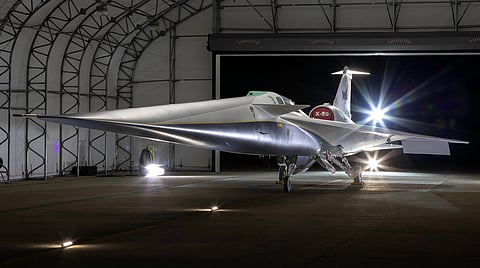

It looks like, well, something weird with wings.
A big shnozz on the front, a single seat for the pilot and an engine of some sort in back. Kinda freakish.
What in blazes is this thing?
Well, they call it the X-59 supersonic demonstrator — a joint project between NASA and the magicians of Lockheed Martin's secretive Skunkworks®.
A one-of-a-kind quiet supersonic aircraft that is part of the US space agency’s mission to make commercial supersonic flight possible.
Super fast, super quiet. Something the Anglo-French Concorde couldn't do, nor the American SST.
Whether it's commercially viable or not, the technology is heading in that direction.
Some day, in the future, your granddaughter might be able to leave Toronto in the morning and make it in time for high tea in London at the Savoy — for the cost of a Business Class ticket.
In a joint ceremony at the Skunkworks® Palmdale, CA, plant on January 12, NASA revealed the X-59 QueSST, an aircraft that is expected to fly at 1.4 times the speed of sound — or 925 mph (1,488 km/h), The Guardian reported.
The aircraft, which stands at 99.7-ft. (30.4 metres) long and 29.5-ft wide, has a thin, tapered nose that comprises nearly a third of the aircraft’s full length — a feature designed to disperse shock waves that would result in sonic booms, the report said.
The latter can startle people and animals, shatter windows, set off car alarms and do other damage.
In attempts to further enhance the aircraft’s supersonic capabilities, engineers positioned the cockpit almost halfway down the length and removed the forward-facing windows.
NASA’s deputy administrator Pam Melroy told the attended aviation media: “We made that decision to make it quieter, but it’s actually an important step forward in and of itself in advancing aviation technology."
“With the huge challenge of limited visibility in the cockpit, the team developed the external vision system, which really is a marvel of high-resolution cameras feeding an ultra-high-resolution monitor.”
On the plane’s exterior are two different camera systems to send imagery to the screen in front of the pilot.
One is a high-definition camera on top of the plane, which peers forward. The other is a retractable, lower-definition camera on the bottom that will look downwards and give the pilot a view of the runway upon landing.
The reason for all of these unique design features — the cameras and smooth underside, the absence of a forward windshield, the long nose, and other elements — is to ideally result in a jet that can slice through the atmosphere quietly.
The X-59 is set to take its first flight later this year and then its first quiet supersonic flight, NASA said.
For the last 50 years, commercial supersonic travel has been banned in the US because of public concerns over explosive sonic booms.
Bob Pearce, NASA’s associate administrator for its aeronautics research mission, said: “Grounded flight testing showed us it was possible to design an aircraft that would produce a soft thump instead of a sonic boom. Is that thump quiet enough to allow supersonic flight over land?
"Our laboratory studies would say yes, but the real answer can only be found by engaging the people who would hear it during daily life.”
Their solution focuses on changing the paths of the shockwaves.
As it jets through the air, a supersonic plane is forcefully pushing aside air molecules, creating shockwaves that move outward, creating a sonic boom.
The area where that sharp noise is heard is called the boom carpet.
The waves can be made to not pile up on one another with the X-59's design, which ensures they are spaced farther apart, creating a less jarring “shaped boom.”
After enough evidence is shared to prove that the QueSST aircraft can be flown safely, NASA plans to expand its flight tests to cities across the US and collect more information about the noise it produces through additional surveys.
Pearce said the X-59’s job would be to collect data from the people below, determine if that sonic thump is acceptable and then turn the data over to US and international regulatory authorities in hopes of lifting the ban.
NASA used the unveiling to underscore the roles that both the agency and the Southern California area have played in the rich American history of pushing aeronautics boundaries.
"This journey actually began in 1947 when the era of supersonic flight started right here in the California high desert with legendary test pilot Chuck Yeager and the X-1," said NASA's Pearce.
Jim Free, NASA's associate administrator, continued this sentiment, telling Space.com the X-59 is merely the latest in a long line of NASA X-planes that have revolutionized aviation throughout the agency's history.
"Even among other X-planes, the X-59 is special. Every aircraft that receives that X-plane designation has a specific purpose to test new technologies or aerodynamic concepts," Free said,
"These special planes push the envelope of what's possible in flight. And once they prove those concepts, they often go into museums. And that's really what makes the X-59 different."
David Nils Larson is the lead test pilot for the X-59.
Prior to joining NASA in 2007, Larson, who retired with the rank of lieutenant colonel, accumulated more than 7,000 hours of military and civilian flight experience in more than 100 fixed- and rotary-winged aircraft.
“That 38-foot nose that we have means that there’s a pretty good space in between that initial nose shock and the next shock that’s going to be created,” says Larson.
NASA and Lockheed aren't the only ones pursuing commercial flight at speeds above the sound barrier.
Colorado-based Boom Supersonic is developing a commercial supersonic passenger jet, the XB-1, which the company hopes to have in the air on its first flight in 2027.
The Federal Aviation Administration has taken a step toward approving these test flights, but the agency’s green light remains outstanding.
— with files from Space.com, The Guardian
